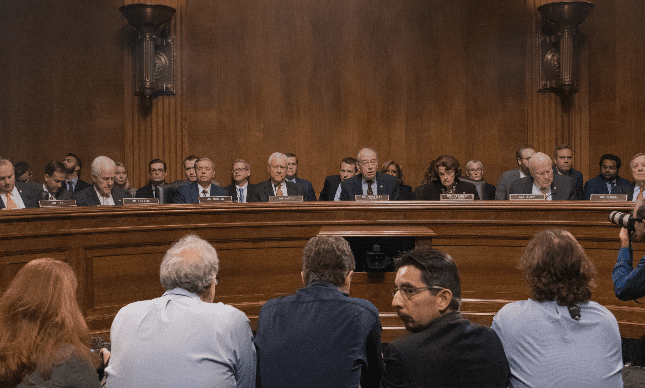
A general view of the U.S. Supreme Court, Friday, June 23, 2023, in Washington. (AP Photo/Mariam Zuhaib)
- Chief Justice Roberts says when a person poses a clear threat, the individual can be disarmed. Justice Thomas dissents, writing that the ban violates the Second Amendment as historically viewed.
The U.S. Supreme Court upheld the prohibition against individuals subject to domestic violence restraining orders from having firearms in a ruling handed down on Friday.
The case, United States v. Rahimi, made its way to the high court after a state court in Tarrant County, Texas, issued a restraining order against Zackey Rahimi in response to his abuse of his girlfriend and mother of their child. The lower court order suspended Rahimi’s gun license for two years.
Rahimi violated the restraining order, contacting his ex-girlfriend through social media.
He was later charged with threatening a different woman with a gun, resulting in a charge for aggravated assault with a deadly weapon. Court documents show that while Rahimi was under arrest for that assault, the Texas police identified him as the suspect in a spate of at least five additional shootings.
Rahimi was indicted on one count of possessing a firearm while subject to a domestic violence restraining order. He would go on to plead guilty to the crimes but later appealing the federal indictment on a Second Amendment challenge.
He is currently serving in prison for the state gun charges stemming from the string of shootings while challenging the federal statute that prohibits a person under such a restraining order from having a firearm, an offense punishable by up to 10 years in prison.
Last year, the U.S. Court of Appeals for the 5th Circuit ruled in Rahimi’s favor, finding the federal statute unconstitutional. U.S. Attorney General Merrick Garland then appealed to the Supreme Court.
In the Supreme Court 8-1 ruling, Chief Justice John Roberts, writing for the majority, said Rahimi’s prosecution over the violation of federal law met the necessary criteria to proceed and “fits comfortably within this tradition.”
“When a restraining order contains a finding that an individual poses a credible threat to the physical safety of an intimate partner, that individual may—consistent with the Second Amendment—be banned from possessing firearms while the order is in effect,” Roberts wrote. “Since the founding, our Nation’s firearm laws have included provisions preventing individuals who threaten physical harm to others from misusing firearms. As applied to the facts of this case, Section 922(g)(8) fits comfortably within this tradition.”
The Chief Justice went on to opine that, “When an individual poses a clear threat of physical violence to another, the threatening individual may be disarmed.”
Justices Elena Kagan and Sonia Sotomayer concurred with the majority, writing, “In short, the Court’s interpretation permits a historical inquiry calibrated to reveal something useful and transferable to the present day, while the dissent would make the historical inquiry so exacting as to be useless, a too-sensitive alarm that sounds whenever a regulation did not exist in an essentially identical form at the founding.”
The dissent to which they refer is that of Justice Clarence Thomas. Thomas sought to decide the case on whether the federal ban is protected by the Second Amendment’s plain text and whether its establishment is consistent with the nation’s historical tradition of firearm regulation.
“When considering whether a modern regulation is consistent with historical regulations and thus overcomes the presumption against firearms restrictions, our precedents ‘point toward at least two metrics [of comparison]: how and why the regulations burden a law-abiding citizen’s right to armed self-defense,'” wrote Thomas. “A historical law must satisfy both considerations to serve as a comparator. While a historical law need not be a ‘historical twin,’ it must be ‘well-established and representative’ to serve as a historical analogue.”
To Thomas, the ban violates the Second Amendment. He also wrote that the government failed to produce any evidence that it is consistent with the nation’s historical tradition of firearm regulation.
“Despite canvassing laws before, during, and after our Nation’s founding, the Government does not identify even a single regulation with an analogous burden and justification,” Thomas continued, adding, “This dearth of evidence is unsurprising because the Founders responded to the societal problem of interpersonal violence through a less burdensome regime: surety laws. Tracing back to early English history, surety laws were a preventative mechanism for ensuring an individual’s future peaceable conduct.”
Justices Neil Gorsuch, Amy Coney Barret, Brett Kavanaugh, and Ketanji Brown Jackson also wrote majority concurring opinions.
You can read the full Supreme Court opinion in the case here.











